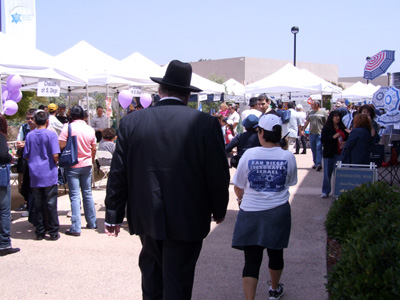

SAN DIEGO—Israeli song, Israeli dance, Israeli politics, Israeli geography, Israeli foods, Israeli merchandise, Israeli trips… they all were components on Sunday, April 25, of the Israel Independence Festival held on the grounds of San Diego Jewish Academy.
Shoshi Bogoch, Israeli shelicha who helped organize the festival, estimated that perhaps 2,000 San Diegans toured the multi-level Carmel Valley campus which had been transformed to a festival area with a blue and white balloon arch, booths, games, exhibits, and an entertainment stage.
Nearly every Jewish organization and synagogue of San Diego County was represented at the one-day fair, and out-of-town Jewish organizations seeking to meet local Jews also were on hand for the 11 a.m. to 3 p.m. event. In total there were 65 booths where information and merchandise were dispensed by vendors and community organizations.
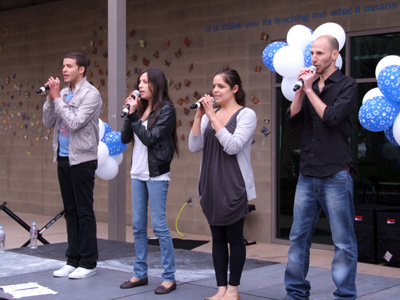
Among the performers was “Kolot,” (Voices), a group of Israeli civilians who came together as a band while they were serving in the Israel Defense Forces. At one point, during their concert, audience members Rick Kamen, Nurit Yeshua and Miriam Plotkin, among others, broke into spontaneous Israeli dance.
Sponsored by the Israel Center of the United Jewish Federation, the Yom Ha’Atzma’ut celebration provided an opportunity “to have the whole community in one place to celebrate Israel together, to learn about Israel and to be able to meet friends from the Jewish community whom you don’t get to see every day,” Bogoch said.
Adults who brought their families were able to “educate their kids that it is important to go to an Israeli event and be part of the community,” the shelicha (emissary) added. “ If you don’t have enough money to go to Israel, you can taste it for one day!”
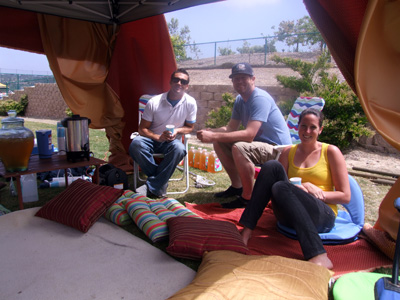
Among popular exhibits was a Bedouin tent erected by the Birthright/ Taglit program, which offers free ten-day trips to Israel for Jewish youth between the ages of 18 and 26 who have never taken an organized trip there before. Three alumni of a San Diego group that made a Birthright trip in January answered questions and told why the experiences of visiting Israel for the first time were meaningful to them.
For Michael Verga, a high point was visiting Ha Kotel (also known as the Western Wall) and “getting the chills there.” He said since returning to San Diego, he has been visiting various congregations, trying to decide which one might be right for him.
For Rebecca Gearty, attending a Shabbat service in a Jerusalem synagogue was moving. In that the service was conducted entirely in Hebrew, “I had absolutely no idea what was going on, but it was so beautiful and so touching to see all this tradition and history come together.” While not particularly interested in affiliating with a congregation at this point of her life, she said she feels a deeper connection both to Israel and to Judaism.
And Michael Nitzani said the visit was a personal revelation for him. He explained that his mother had been divorced from his Israeli father when he was only 5, so the trip helped satisfy a long-standing curiosity about what his father’s country was like. “It helped me rekindle a connection with my father,” he said.
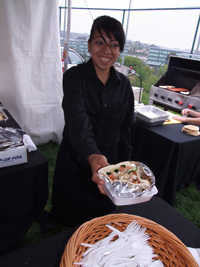 Not far away, two local kosher caterers—The Place and Schmoozers—served up various grilled items, including shawarma, an Israeli/ Arab delicacy of thinly sliced meat and vegetables served inside a pita pocket.
Not far away, two local kosher caterers—The Place and Schmoozers—served up various grilled items, including shawarma, an Israeli/ Arab delicacy of thinly sliced meat and vegetables served inside a pita pocket.
On the upper level, one could see items of Judaica for sale, including umbrellas bearing blue Stars of David.
Bogoch said the Israel Festival celebrating 62 years of Israeli independence had more participation of Orthodox congregations than previously, despite the fact that Yom Ha’Atzma’ut comes during the period of the counting of the Omer, traditionally a period when people refrain from merrymaking.
To accommodate those who felt the need to separate themselves from the singing and dancing, festival organizers created a “quiet area” inside one of the San Diego Jewish Academy’s buildings where lectures were featured.
Rabbi Jeffrey Wohlgelernter of Congregation Adat Yeshurun was among those who lectured on Israel, choosing as his topic the spiritual aspects of the cities of Hebron and Jerusalem.
He said that Hebron comes from a Hebrew word meaning “attached” and there is a tradition in Judaism that the Machpelah – the Cave of the Patriarchs—is where the physical and spiritual worlds of Judaism are attached.
Recalling the Torah account of three visitors advising Abraham that he and Sarah, notwithstanding their advanced age, would have a child, Rabbi Wohlgelernter said when Abraham searched for a cow to slaughter for these holy visitors, he came across the cave, where he found the bodies of Adam and Eve – who, though dead, were not decomposed and were surrounded with candles. In such a way, he said, the tradition links the notion of eternity – from Adam and Eve to the future generations that would be born to Sarah and Abraham.
In Hebrew, Machpelah refers to “double tombs” and those buried in the Holy Cave, by tradition, are such biblical couples as Adam and Eve, Abraham And Sarah, Isaac and Rebecca, and Jacob and Leah, the rabbi said.
The name “Jerusalem,” said the rabbi, invokes two concepts. One is that of a place of completeness; the other that “God will be seen.”
He recalled that there were three festivals in which residents were enjoined to visit the Temple in Jerusalem — Pesach, Succot and Shavuot–and said when those who came from Hebron stopped in Talpiot, the area of Jerusalem today dominated by the Haas Promenade, they could see a magnificent view of the Temple complex with a pillar of smoke rising from the area at the Holy of Holies.
This pillar, the same as the one that had led Moses and the Israelites from Egyptian bondage, went straight up into the sky like a column, no matter how forceful the winds or the rains, said Wohlgelernter. In such fashion was God seen, the rabbi said.
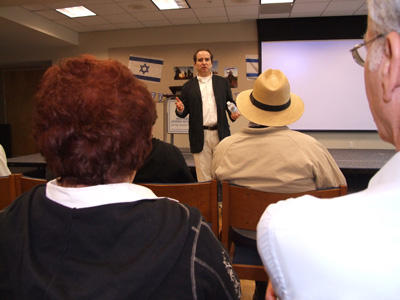
Another speaker was Gil Artzyeli, Israel’s deputy consul general in Los Angeles. In an informal question and answer session with attendees, he contrasted the physical deterioration of Gaza with the economic growth in the West Bank under Palestinian Prime Minister Salam Fayyad. When Israel withdrew from Gaza, he noted, it left behind working greenhouses which could have been utilized by the Palestinians the very next day for the export of vegetables to Europe. In Ramallah, on the other hand, he said Fayyad is proving himself the first Palestinian leader who wants to improve the lot of the Palestinians and not simply battle Israelis.
Although the government in the West Bank and Hamas in Gaza are bitter rivals, which makes creation of a single Palestinian state problematic, it is assumed someday the two portions of Palestine will be united. How can the two be contiguous without severing Israel, the diplomat was asked. He responded that one likely scenario is a “very fast bullet train” that could speed Palestinians through Israeli territory without stopping.
*
Harrison is editor of San Diego Jewish World